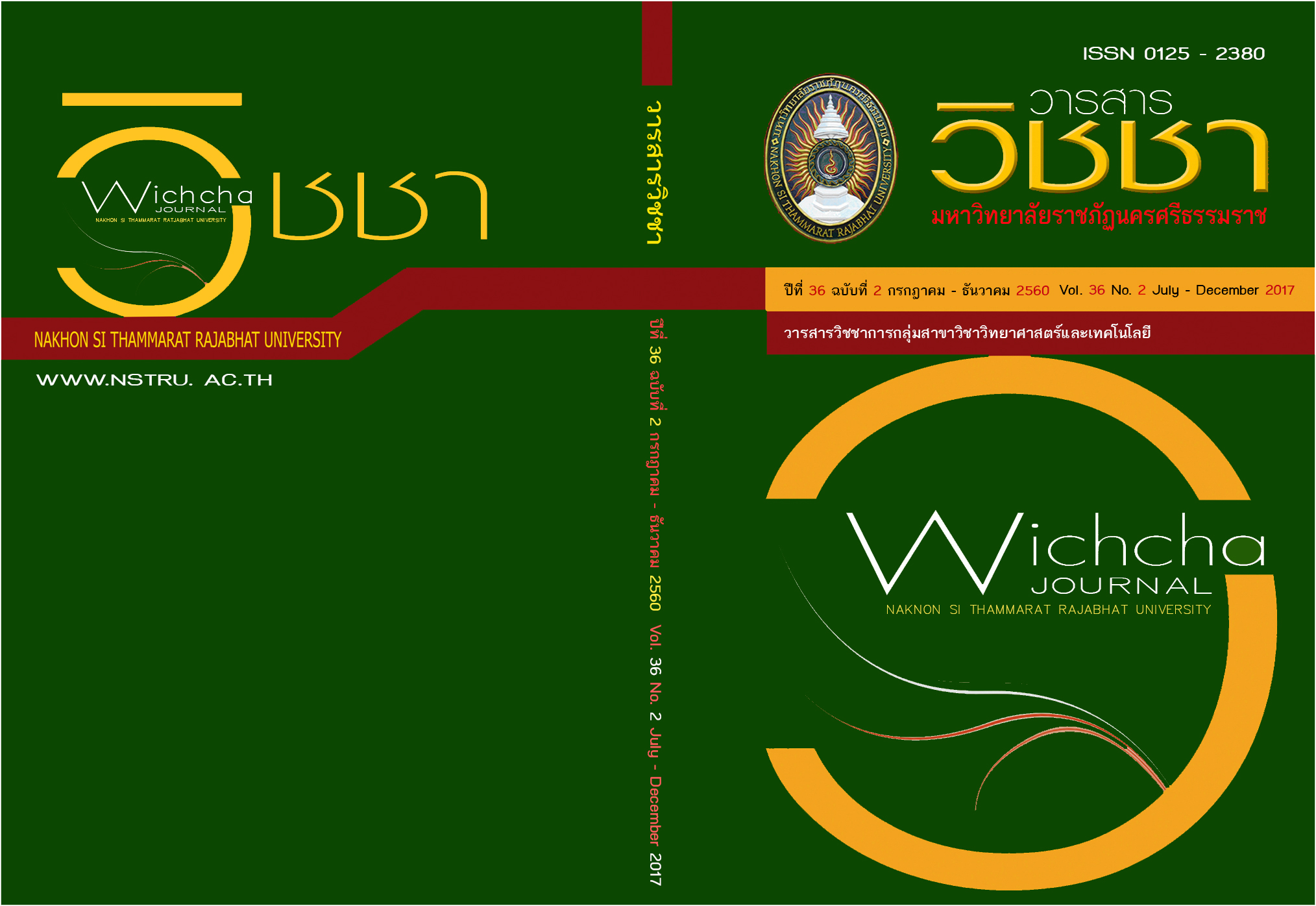A study of total viable count and Staphylococcus aureus contamination in rolled up salad, wrapped noodle and wrapped noodle with vegetables nearby Burapha University, Chonburi Province
Main Article Content
Abstract
A study of total viable count (TVC) and Staphylococcus aureus contamination in rolled up salad, wrapped noodle and wrapped noodle with vegetables were carried out. Fourty-eight samples were collected from local shops near Burapha University, Chonburi Province during August to December, 2016. Fourty-eight samples (100%) were contaminated with microorganisms (TVC) (1.10 ± 0.03 x 105 CFU/g - 1.27 ± 0.23 x 109 CFU/g) and TVC of 33 samples (68.5%) were higher than standard recommended by the Department of Medical Sciences (2010) for the ready-to-eat food. Fourteen out of fourty-eight samples (29.1%) were positive for S. aureus (1x10 CFU/g - 5.2 x 104 CFU/g). The number of S. aureus detected in 8 samples (16.6%) were higher than standard recommended by the Department of Medical Sciences (2010) for the ready-to-eat food. These results demonstrated contamination of microorganisms (TVC) and S. aureus in rolled up salad, wrapped noodle and wrapped noodle with vegetables samples suggesting the risk of foodborne illness due to consumption these foods is high. There is a need to enforce good practices to avoid contamination of pathogen in rolled up salad, wrapped noodle, wrapped noodle with vegetables
Article Details
เนื้อหาและข้อมูลในบทความที่ลงตีพิมพ์ในวารสารวิชชา มหาวิทยาลัยราชภัฏนครศรีธรรมราช ถือเป็นข้อคิดเห็นและความรับผิดชอบของผู้เขียนบทความโดยตรง ซึ่งกองบรรณาธิการวารสารไม่จำเป็นต้องเห็นด้วยหรือร่วมรับผิดชอบใด ๆ
บทความ ข้อมูล เนื้อหา รูปภาพ ฯลฯ ที่ได้รับการตีพิมพ์ในวารสารวิชชา มหาวิทยาลัยราชภัฏนครศรีธรรมราช ถือเป็นลิขสิทธ์ของวารสารวิชชา มหาวิทยาลัยราชภัฏนครศรีธรรมราช หากบุคคลหรือหน่วยงานใดต้องการนำข้อมูลทั้งหมดหรือส่วนหนึ่งส่วนใดไปเผยแพร่ต่อหรือเพื่อการกระทำการใด ๆ จะต้องได้รับอนุญาตเป็นลายลักษณ์อักษรจากวารสารวิชชา มหาวิทยาลัยราชภัฏนครศรีธรรมราชก่อนเท่านั้น
The content and information in the article published in Wichcha journal Nakhon Si Thammarat Rajabhat University, It is the opinion and responsibility of the author of the article. The editorial journals do not need to agree. Or share any responsibility.
References
ดาริวรรณ เศรษฐีธรรม,กาญจนา นาถะพินธุ, จรัสศรี นามแก้ว และ ภัควลัญชณ์ จันทรา. (2556). สถานการณ์การปนเปื้อนจุลินทรีย์ในอาหารพร้อมบริโภค: กรณีศึกษา จังหวัดขอนแก่นและอุดรธานี. วารสารวิจัยสาธารณสุขศาสตร์ มหาวิทยาลัยขอนแก่น, 6(2), 145-159.
พิมพ์เพ็ญ พรเฉลิมพงศ์ และนิธิยา รัตนาปนนท์. (2557). Staphylococcus aureus. ค้นเมื่อ กันยายน 17, 2559, จาก http://www.foodnetworksolution.com/ wiki/word/1197/ staphylococcus-aureus-สตาฟิโลค็อกคัส-ออเรียส
วีรนุช หลาง. (2552). คู่มือตรวจวิเคราะห์ด้านจุลชีววิทยาทางอาหาร (พิมพ์ครั้งที่ 1). กรุงเทพฯ: สำนักพิมพ์มหาวิทยาลัยเกษตรศาสตร์.
ศิวาพร ศิวาเวช. (2542). การสุขาภิบาลโรงงานอุตสาหกรรมอาหาร. นครปฐม: มหาวิทยาลัยเกษตรศาสตร์ คณะอุตสาหกรรมเกษตร ภาควิชาวิทยาศาสตร์ และเทคโนโลยีการอาหาร.
ศิริพร ทวีโรจนการ. (2552). การตรวจสอบคุณภาพทางจุลินทรีย์ในอาหารพร้อมบริโภคที่จำหน่าย
บริเวณมหาวิทยาลัยราชภัฎสุราษฎร์ธานี. ค้นเมื่อ เมษายน 21, 2560, จาก http://eresearch.sru.ac.th/?q=system/files/การตรวจสอบคุณภาพ ทางจุลินทรีย์.pdf.
สุดสายชล หอมทอง จิราพร ตันวุฒิบัณฑิต ณัฐชนาภัทธ ดังก้อง อําไพ บุตรงาม และบุณฑริกา นิลโนรี. (2554). การแพร่กระจายของ Staphylococcus aureus และ Bacillus cereus ในซูชิ. วารสารวิทยาศาสตร์บูรพา, 16, 69-76.
Aycicek H., Cakiroglu S. & Stevenson T.H. (2005). Incidence of Staphylococcus aureus in ready-to-eat meals from military cafeterias in Ankara, Turkey. Food Control, 16, 531-534.
Balzaretti C.M. & Marzano M.A. (2013). Prevention of travel-related foodborne diseases: Microbiological risk assessment of food handlers and ready-to-eat foods in northern Italy airport restaurants. Food Control, 29, 202-207.
Bennett R.W. & Lancette G.A. (2001). Bacteriological Analytical Manual, Chapter 12“Staphylococcus aureus” Retrieved January 14, 2017, from http://www.fda.gov/Food/FoodScienceResearch/LaboratoryMethods/ucm071429.htm.
Castro A., Santos C., Meireles H., Silva J. & Teixeira P. (2016). Food handlers as potential sources of dissemination of virulent strains of taphylococcus aureus in the community. Journal of Infection and Public Health, 9, 153-160.
Huong B.T.M., Mahmud Z.H., Neogi S.B., Kassu A., Nhien N.V., Mohammad A., Yamato M., Ota F., Lam N.T., Dao H.T.A. & Khan N.C. (2010). Toxigenicity and genetic diversity of Staphylococcus aureus isolated from Vietnamese ready-to-eat foods. Food Control, 21, 166-171.
Jay M.J. (2000). Modern Food Microbiology 6TH Edition. Springer,USA.
Kroning I.S., Iglesias M.A., Sehn C.P., ValenteGandra T. K., Mata M.M. & daSilva W.P. (2016). Staphylococcus aureus isolated from handmade sweets: Biofilm formation, enterotoxigenicity and antimicrobial resistance. Food Microbiology, 58,105-111.
Maturin L. & Peeler J.T. (2001). Bacteriological Analytical Manual. Chapter 3 “Aerobic Plate Count” Retrieved October 8, 2016, from http://www.fda.gov/Food/FoodScienceResearch/LaboratoryMethods/ucm063346.htm.


